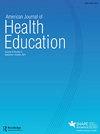心血管疾病和身体活动表型与中年和老年人跌倒的关系:2018年行为风险因素监测系统
IF 0.8
Q4 PUBLIC, ENVIRONMENTAL & OCCUPATIONAL HEALTH
引用次数: 0
摘要
背景:体力活动(PA)在降低成人心血管疾病(CVD)患者跌倒风险中的作用尚不清楚。目的研究CVD-PA表型与跌倒的关系。方法≥45岁成人(n = 295282;N = 130,103,093)来自2018年行为风险因素监测系统,他们自我报告心血管疾病,休闲时间PA和跌倒。评估所有CVD-PA表型(无CVD-PA、无cvd -无PA、CVD-PA、cvd -无PA)的任何、复发性和伤害性跌倒的加权患病率(PR)。结果在完全调整模型中,不健康CVD-PA表型的患者发生任何、复发性和伤害性跌倒的可能性更高。在总样品中,无cvd -无PA (PR: 1.30;95% ci: 1.10, 1.50), cvd-pa (pr: 1.35;95% CI: 1.10, 1.60)和CVD-no - PA (PR: 1.39;95% CI: 1.11, 1.67)表型的患者比无CVD-PA表型的患者更容易报告伤害性跌倒。在有心血管疾病风险的中年和老年人中,参与休闲时间的PA可能是预防跌倒的重要生活方式策略。我们的研究结果可能有助于健康教育,为未来有心血管疾病和跌倒风险的成年人的跌倒预防项目提供证据。本文章由计算机程序翻译,如有差异,请以英文原文为准。
Association of Cardiovascular Disease and Physical Activity Phenotypes with Falls among Midlife and Older Adults: 2018 Behavioral Risk Factor Surveillance System
ABSTRACT Background The role of physical activity (PA) in mitigating fall risk among adults with cardiovascular disease (CVD) is unclear. Purpose We examined the associations of CVD–PA phenotypes with falls. Methods Adults ≥ 45 years (n = 295,282; N = 130,103,093) from the 2018 Behavioral Risk Factor Surveillance System who self-reported CVD, leisure-time PA, and falls were examined. The weighted prevalence ratio (PR) of any, recurrent, and injurious falls across CVD–PA phenotypes (no CVD–PA, no CVD–no PA, CVD–PA, CVD–no PA) was estimated. Results The likelihood of any, recurrent, and injurious falls was higher across unhealthier CVD–PA phenotypes in fully adjusted models. In the total sample, no CVD–no PA (PR: 1.30; 95% CI: 1.10, 1.50), CVD–PA (PR: 1.35; 95% CI: 1.10, 1.60), and CVD–no PA (PR: 1.39; 95% CI: 1.11, 1.67) phenotypes were more likely to report injurious falls than no CVD–PA phenotype. Discussion Engaging in leisure-time PA may be an important lifestyle strategy for fall prevention in midlife and older adults who are at risk of CVD. Translations to Health Education Practice Our findings could be useful for health education in providing evidence on future fall prevention programs in adults who are at risk for CVD and falls.
求助全文
通过发布文献求助,成功后即可免费获取论文全文。
去求助
来源期刊

American Journal of Health Education
PUBLIC, ENVIRONMENTAL & OCCUPATIONAL HEALTH-
CiteScore
1.70
自引率
10.00%
发文量
36
期刊介绍:
AJHE is sponsored by the American Association for Health Education of the American Alliance for Health, Physical Education, Recreation and Dance. The mission of the American Association for Health Education(AAHE) is to advance the profession by serving health educators and others who strive to promote the health of all people through education and other systematic strategies.AAHE addresses the following priorities •Develop and promulgate standards, resources and services regarding health education to professionals and non-professionals •Foster the development of national research priorities in health education and promotion. Provide mechanisms for the translation and interaction between theory, research and practice.
 求助内容:
求助内容: 应助结果提醒方式:
应助结果提醒方式:


